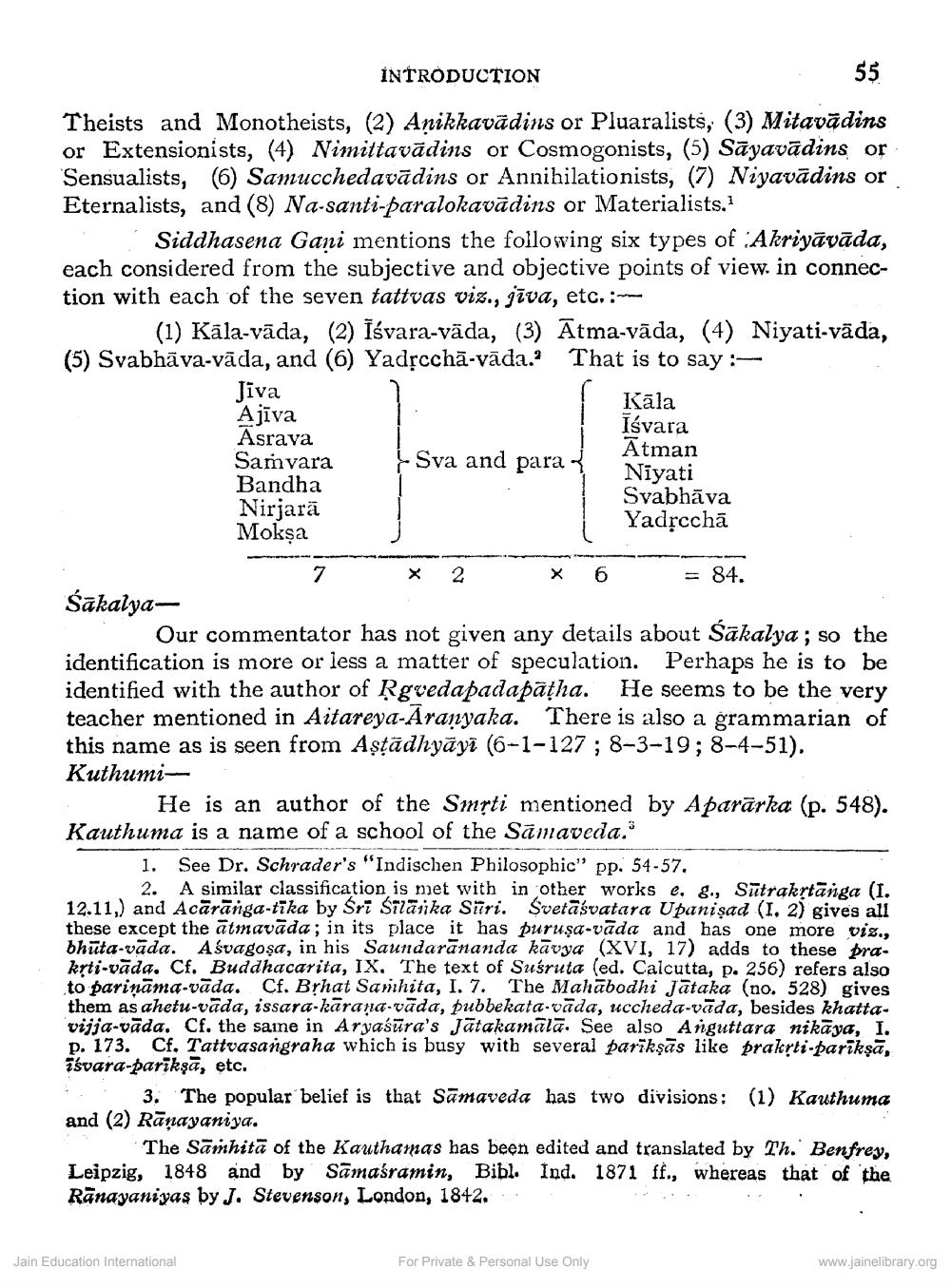________________
INTRODUCTION
55 Theists and Monotheists, (2) Anikkavādins or Pluaralists, (3) Mitavādins or Extensionists, (4) Nimittavādins or Cosmogonists, (5) Sāyavādins or Sensualists, (6) Samucchedavādins or Annihilationists, (7) Niyavādins or Eternalists, and (8) Na-santi-paralokavādins or Materialists.
Siddhasena Gani mentions the following six types of Akriyāvāda, each considered from the subjective and objective points of view. in connection with each of the seven tattvas viz., jīva, etc.:
(1) Kāla-vāda, (2) īśvara-väda, (3) Atma-vāda, (4) Niyati-vāda, (5) Svabhāva-vāda, and (6) Yadşcchā-vāda. That is to say :Jiva
Kāla Ajīva
īśvara Asrava
Sva and para Samvara
Atman
Niyati Bandha
Svabhāva Nirjara
Yadrcchā Mokşa
7 1 x 2 x 6 = 84. Šakalya
Our commentator has not given any details about Śākalya ; so the identification is more or less a matter of speculation. Perhaps he is to be identified with the author of Rgvedapadapatha. He seems to be the very teacher mentioned in Aitareya-Aranyaka. There is also a grammarian of this name as is seen from Aşțādhyāyż (6-1-127 ; 8-3-19; 8-4-51). Kuthumi
He is an author of the Smrti mentioned by Aparārka (p. 548). Kauthuma is a name of a school of the Sāmaveda,
1. See Dr. Schrader's "Indischen Philosophic" pp. 54-57.
2. A similar classification is met with in other works e. g., Sütrakrtanga (I. 12.11,) and Acāranga-tika by Sri Sriālika Suri. Svetāśvatara Upanişad (I. 2) gives all these except the ātmavāda; in its place it has puruşa-vada and has one more viz., bhūta-vada. Ašvagoşa, in his Saundarananda kavya (XVI, 17) adds to these prakrti-vāda. Cf. Buddhacarita, IX. The text of Suśruta (ed. Calcutta, p. 256) refers also to parināma vāda. Cf. Brhat Samhita, I. 7. The Mahabodhi jātaka (no. 528) gives them as ahetu-vada, issara-kārana-vāda, pubbekata-vāda, uccheda-vāda, besides khattavijja-vada. Cf. the same in Aryaśūra's Jätakamālā. See also Anguttara nikāya, I. p. 173. Cf. Tattvasangraha which is busy with several parikşās like prakrti-pariksa, īśvara-parikşā, etc.
3. The popular belief is that Sāmaveda has two divisions: (1) Kauthuma and (2) Rānayaniya.
The Sāmhitā of the Kauthamas has been edited and translated by Th. Benfrey, Leipzig, 1848 and by Sāmaśramin, Bibl. Ind. 1871 ff., whereas that of the Ranayaniyas by J. Stevenson, London, 1842
Jain Education International
For Private & Personal Use Only
www.jainelibrary.org




